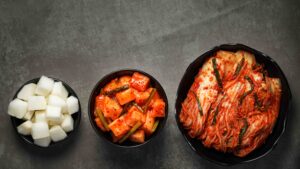Fermentation is the chemical process in which molecules of glucose are broken down anaerobically in the presence of microorganisms like yeast and Lactobacillus. This process is used to bring about desirable changes in food and beverages. it is performed by microorganisms in the absence of oxygen for the formation of energy from carbohydrates as a means of survival. For centuries, humans have used fermentation in producing food like the popular kimchi, yogurt, pickles and alcoholic beverages like wine, sake, beer, etc. Fermentation occurs inside the bodies of all animals too. For e.g. Yakult is a probiotic drink to aid our digestive track develop good bacteria gut and to improve the gut fauna for better digestion.

Korean food, Cabbage kimchi and Radish kimchi and Pickled radish in black bowl set on dark background.
Equation of Fermentation
Fermentation breaks down one molecule of glucose into two molecules of glucose and two molecules of carbon dioxide in the absence of oxygen. Two molecules of ATP are also produced during the procedure. The chemical equation of the fermentation is: C6H12O6à 2C2H5+ 2CO+ 2ATP
Aroma of wine and sake
The wine is produced industrially by converting grape juice into wine in the presence of yeast. Yeast transform sugar present in the grape juice into ethanol and carbon dioxide. Winemaking involves careful contemplation of the speed of fermentation and temperature. Wine and sake have a peculiar aroma which is the result of aroma compounds called stereoisomers of common organic compounds such as diacetyl produced during the fermentation process. Some of the aromas of wine come from the formation of esters. Esters are formed by the reaction of alcohol and acids present in the wine. There are several volatile aroma compounds in wine that determine its aroma. Sake is a national beverage of Japan. It is an alcoholic beverage that is made by fermenting rice. It is also called rice wine. It is widely used as a beverage as well in culinary. Sake fermentation takes almost six weeks to occurs and involves three processes.
- Combining steamed rice and water.
- Adding yeast to the mixture.
- Temperature control sake brewing.
- Distillation and packing.
Anaerobic condition
Anaerobic respiration is the production of energy by the breakdown of glucose in the absence of oxygen. The end product of anaerobic respiration is lactic acid rather than water and carbon dioxide. This process transfers energy from glucose to the cells. This process results in the production of a large amount of energy.
Anaerobic fermentation and production of Ethanol
Anaerobic fermentation is a rather slow process. It is applied in the production of many products industrially. The most important procedure is the production of ethanol using s.cerevisiae and other yeasts. Within the fermentation which occurs in absence of Oxygen, glycolysis occurs first by the breakdown of glucose into pyruvate then to acetate, and then finally into ethanol. The chemical equation for the production of ethanol is C6H12O6à2C2H5OH + 2CO2 The formation of Ethanol using fermentation is called alcohol fermentation. It is a two-step process which involves first step of removal of carboxyl group from pyruvate using enzyme pyruvate decarboxylase giving carbon dioxide gas and acetaldehyde. The second step involves using enzyme alcohol dehydrogenase that transports one electron from NADH to acetaldehyde resulting in NAD+ and ethanol. Pyruvic acidà CO2 + acetaldehyde Acetaldehyde à NAD+ + Ethanol
Industrial Fermentation
Industrial fermentation is the intentional fermenting to produce food and alcoholic beverages at the commercial level. It involves different microorganisms like bacteria, fungi, eukaryotic cells like CHO, and insect cells.
Microorganisms used in the fermentation
Yeast
Fermentation cannot take place without microorganisms. The most common microorganism used to bring about fermentation in foods industrially is Yeast- a fungus. This microorganism is widely present from the skin of the fruit to the intestine of the animals. Yeast brings glycolysis which is a breakdown of sugar into ethanol and carbon dioxide.
Fermentative Bacteria
Several fermentative bacteria produce methane in the rumen of the cattle, sewage digesters, and sediments. They produce formate, carbon dioxide, hydrogen, acetate, and carboxylic acids. Then acetate and carbon dioxide are converted into methane. Acetogenic bacteria and methanogen bacteria aid in the final production of methane.
Fermentation in foods
Fermentation in foods leads to the biochemical and nutritional value change to the obtained food as compared to the mother food. Fermenting food involves complex procedures involving enzymes and metabolic activities of microorganisms used. There have been several foods made by the process of fermentation using natural cultures. The three widely fermented used foods are discussed below.
Kimchi
Kimchi is a famous traditional food in Korean cuisine. It is made up of vegetables and spices. Since it is produced by the fermentation process, lactic acid is produced to give a sour flavor to the dish. Yes, this is the same molecule that causes muscle aches in your body after a day of strenuous exercising! The fermentation in kimchi involves wild cultures of bacteria that are present on the skin of the vegetables. The fermentation in the kimchi is a quick process and takes place within just 1-2 days at room temperature.
Pickles
Pickles are widely used food that consists of multiple or single vegetables stored in water and vinegar. The pickling involves the formation of lactic acid aided by lactobacillus bacteria already present in the vegetables. The rate of fermentation depends upon many factors like the cut of a vegetable, type of vegetable, amount of salt used, and moisture content. Kimchi is a type of fermented pickle now loved by many people outside of Korea. There are many cultures that preserve their vegetables by ferementation, including Japan, Pakistan etc. Each have thei own unique way of preparing the vegetables but the common molecule present is lactic acid.
Yogurt
Yogurt is a type of food that is made from milk and is used globally. It has tremendous health benefits. It is made by fermenting milk with Lactobacillus bacteria in a controlled environment. The rate at which yogurt is prepared depends upon the temperature and amount of culture used. The whole process revolves around breaking down sugar present in milk using Lactobacillus into Lactic Acid and Carbon dioxide. This process of fermentation involved in the above-mentioned foods is called Lacto-Fermentation for its use of Lactobacillus as a culture to introduce fermentation technique. The equation for converting sugars in Lactic acids using Lactobacillus is C6H12O6 à 2CH3CH(OH)CO2H The fermentation process involves the breakdown of sugars present in the food into lactic acid which makes food acidic to the extent which is safe to eat.
Conclusion
The fermentation process is aided using micro organisms. It is widely used for industrial purposes. Our food industries bring about fermentation at a commercial scale using the right amount of culture and optimum temperature and moisture level. The formation of alocoholic beverages and ethanol involve several steps and precise calculations to produce desired result.

